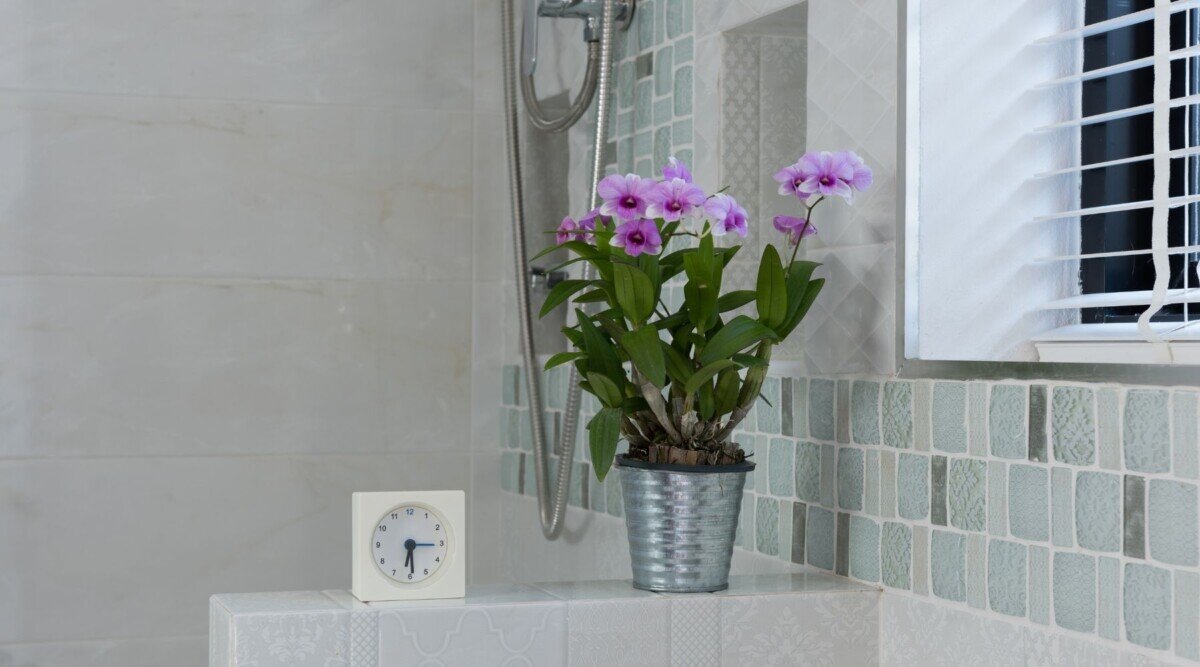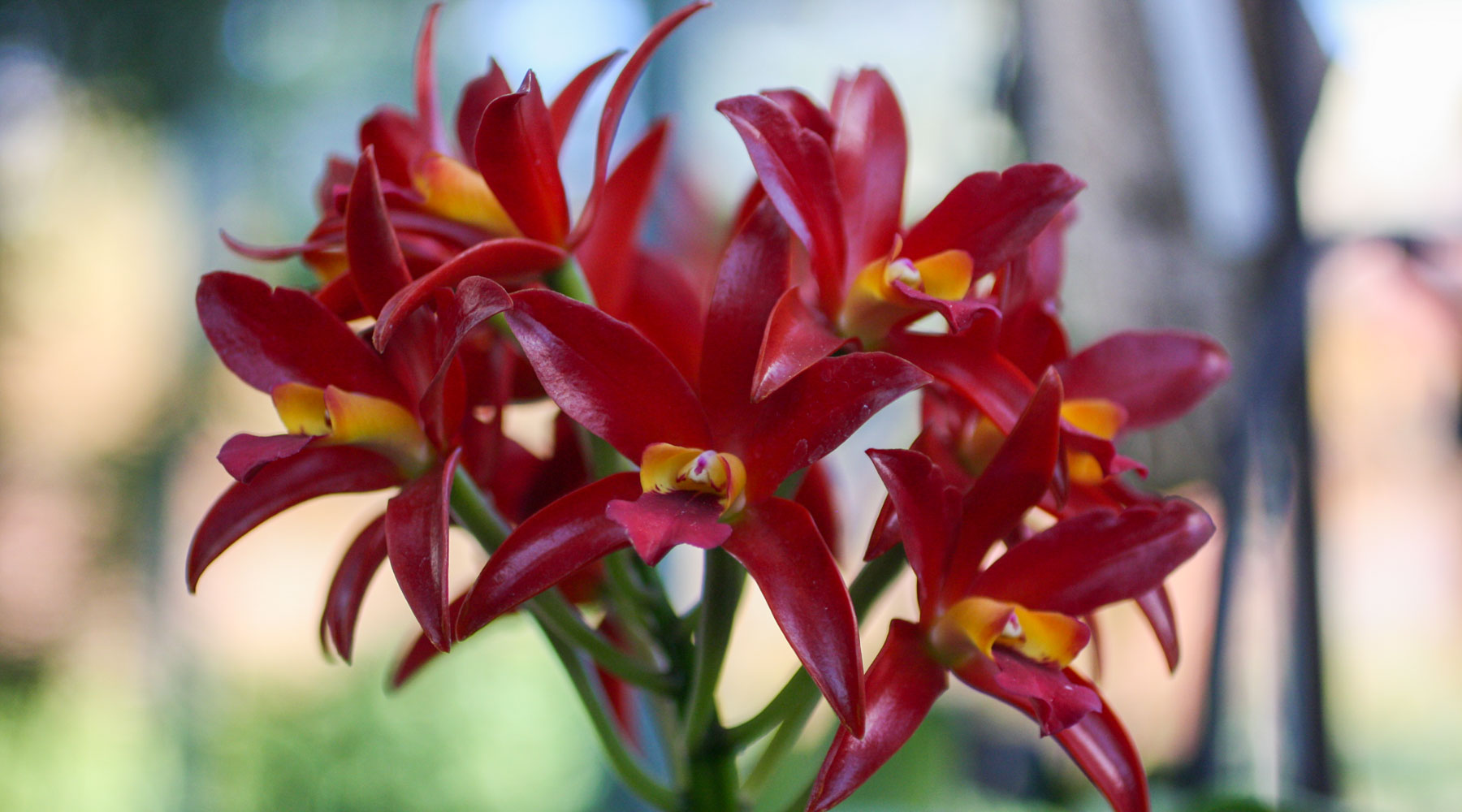
Orchids are fragrant and showy flowers that can be the perfect addition to any indoor space. Are you considering getting one for your office but aren’t sure you can take care of it?
Caring for orchids in an office isn’t difficult as long as you know their needs. Light, humidity, water, temperature, proper potting media, fertilizer, and air circulation are essential orchid requirements. On the other hand, overwatering, overfeeding, and too much light can kill your plant.
Throughout this article, we’ll talk about how to grow orchids in your office and how to keep them alive. We’ll also elaborate on the reasons you should have orchids in your office.
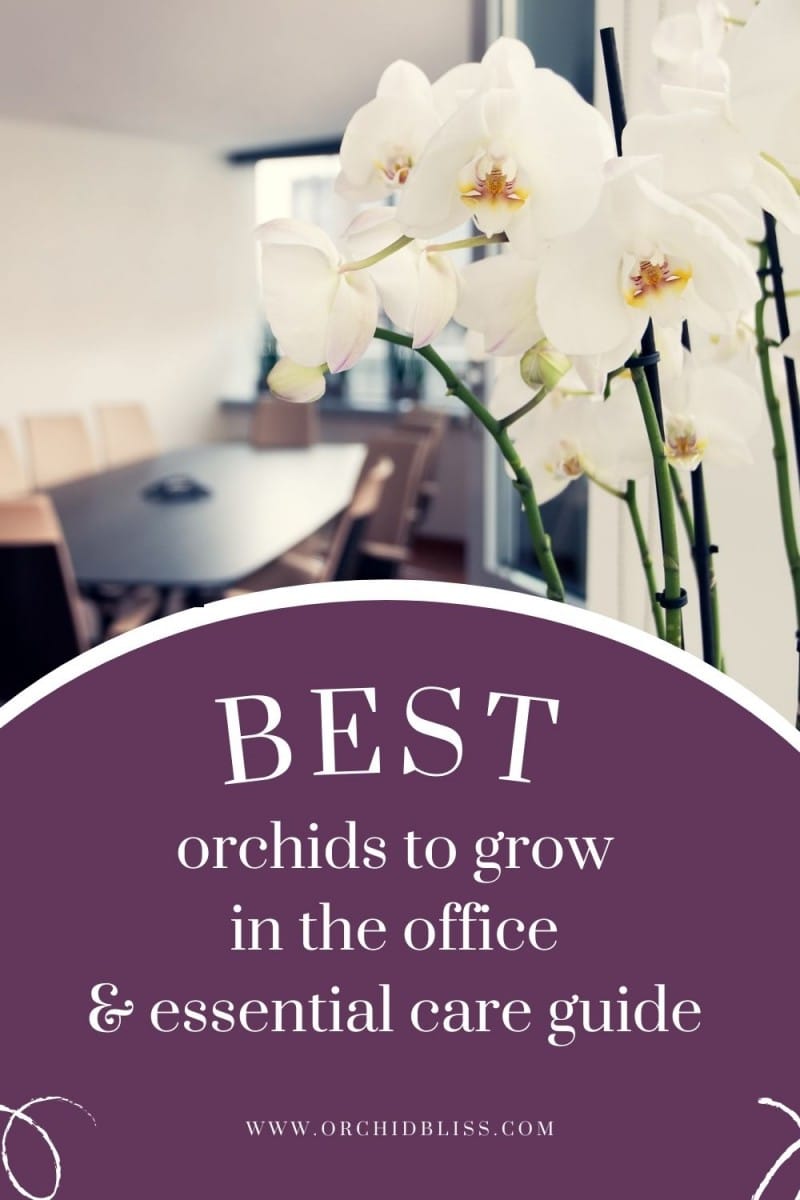
How to Grow Orchids in an Office
Generally speaking, orchids can thrive both outdoors and indoors, provided that you satisfy their needs. That’s why orchids are one of the most widely sold houseplants.
However, keeping an orchid in your office may be a little trickier than having one at home or in your greenhouse. After all, you may not have much control over the physical conditions, and you probably can’t monitor your plant 24/7.
Nevertheless, the orchid’s vibrant beauty is too tempting not to consider it as an addition to your office. The good news is, with a little care and love, you can enjoy having this beauty at the office. Here’s what you need to do to grow orchids in your office:
Choose the Right Species
With more than 28000 species worldwide, choosing the right orchid for your office might be overwhelming. They vary widely in terms of appearance, size, and characteristics. Some are high-maintenance, while others can be more tolerant, especially of drought.
Another unique feature is that orchids grow in two different mediums. Epiphytic orchids have aerial roots that don’t need soil to grow. So, you can either mount them or pot them in a bark-based medium. Terrestrial orchids are earth-growing and need soil in their pots.
The best orchid species for office space include the following:
- Lady’s slipper or Paphiopedilum is particularly suitable because it doesn’t need much light. It only needs watering once a week and blooms in late winter. It’s also compact so you can fit it in any office space.
- Oncidium orchids may perform well in an office space. The roots should moderately dry between two waterings. It’s suitable for office space because it doesn’t like being moved. So, it’s better to keep it in the same spot for a long time. Many oncidiums have a lovely fragrance.
- Phalaenopsis enjoys normal indoor light and needs watering only once a week. This species is called the moth orchid. And it’s one of the easiest orchids to grow indoors. The flowers are long-lasting, staying in bloom for three months. Plus, happy, healthy plants can flower twice a year.
Know Their Potting Requirements
The orchids you buy from the market come in plastic pots with roots that aren’t in the best condition. You might even see them soaking in water and close to rotting. So, the first thing you should do is replace the pot with something suitable for the orchid, which also looks good in your office.
To remove the orchid from its original pot, pick it up by the leaves and turn it upside down. It should come out of the pot quickly. If the pot is plastic, you can cut it away.
Gently remove the potting medium to avoid hurting the roots and throw it away. Carefully check the roots to see if they’re blackened, spongy, or damaged in any other way. Healthy roots should be plump, white, or green. Cut off any damaged roots.
Then, place the orchid upright and cover it with a new potting medium up to one inch from the top. Press down the medium gently and water it well to make it settle around the roots. If you feel it needs more medium, add some more.
Some plants need staking, either because they grow out of the pot or because they initially need some support until they can cling to the new medium. Curly willow or green bamboo are good choices. To learn more about repotting orchids, click here.
Choose the Right Potting Medium
Orchids need special potting media to thrive, even the terrestrial ones. The medium should be porous and light to allow for fast drainage and air movement around the roots. It should also be slow-decomposing and moisture-preserving.
There’s no one perfect mix that works for all orchids, but there are some standard mixes that you can start and experiment with to see if they work well. For instance, If your orchid is large and has old roots, put it in coarse potting media. But terrestrial orchids need a denser medium containing some sand and sphagnum moss.
You can get orchid potting mixes from garden stores. The best growing medium is a combination of fine, medium, and coarse bark chunks and perlite and peat. Sphagnum moss and horticultural charcoal are also great choices. However, be careful not to use too much sphagnum moss as it can preserve too much water.
The potting mix I use and trust is from rePotme. Their all-purpose orchid mix is made with medium and small Monterey Pine Park and medium sponge rock. What I really love about rePotme is that you can get a customized potting mix for many favorite orchid varieties, including phalaenopsis, cattleya, dendrobium, paphiopedilum, and phragmipedium, cymbidium, and even jewel orchids.
Fine bark is good for retaining moisture, while coarse bark is good for air circulation. Fir bark decomposes faster than tree fern, but the latter is more expensive and doesn’t retain moisture well.
Perlite is a type of volcanic glass that resembles Styrofoam bits, also known as volcanic popcorn. It’s porous and retains moisture and nutrients while draining extra moisture effectively. Since it’s disease-free, inexpensive, and non-toxic, it’s a perfect choice to go in your media mix. But don’t use it alone since it can preserve too much water. To learn more about orchid potting mixes, click here.
Choose the Right Pot
Choosing the perfect pot for your orchid can be tricky. It should be large enough so that the plant doesn’t outgrow it quickly. Generally speaking, you should choose a pot that your plant lives in for one or two years. Standard orchid pots measure between 4 and 6 inches (10.16 and 15.24 cm). But if you’re not sure what size pot to get, look at the previous pot and choose the new one slightly bigger.
Orchid roots need ample airflow, so the best pots for them are terra cotta pots, which are popular among growers because they’re porous.
Ceramic pots are also popular due to their beautiful designs. But some of them don’t have drainage holes. You could put the orchid in a well-drained cheap plastic pot and place it inside the ceramic pot in such cases. Other special orchid containers have wide draining slits on all sides of the pot.
The pot should be large enough to give the roots one inch of space to grow in all directions. But if you see your pot is a little oversized, you can fill it with packing peanuts. Click here to learn more about orchid pots.
Pick the Right Spot for the Plant
Light helps orchids stay healthy. While you might be tempted to show off your beautiful addition by putting it on your desk, it may not be the best place.
Orchids need lots of bright, indirect sunlight, so it’s best to put them at the window. If your office doesn’t have windows or you work in a cubicle, you may want to consider another plant.
Some species can thrive under artificial light, such as Phalaenopsis or Paphiopedilum. Others like Vandas and Cymbidiums must have access to natural sunlight.
Temperature is also another crucial factor that affects orchid growth. In addition to the proper range of 50 to 85° F (10 to 30° C), orchids need to experience a natural 10-degree drop in the temperature at night. So, if your office’s temperature stays at a constant level or it can’t allow for this drop, your orchid might stop growing or not bloom.
Besides, if you put your orchid on a windowsill, make sure it gets the natural temperature drop it needs.
How to Keep Orchids Alive in an Office
Having an orchid in your office is one thing, and keeping it alive is another. If you’re a busy person who doesn’t have the time to water your plants, then orchids aren’t for you. Orchids are relatively high-maintenance and need real pampering on your part.
So, if you’re ready to go the extra mile to take care of the plant, here’s what you should do to keep it alive in an office setting.
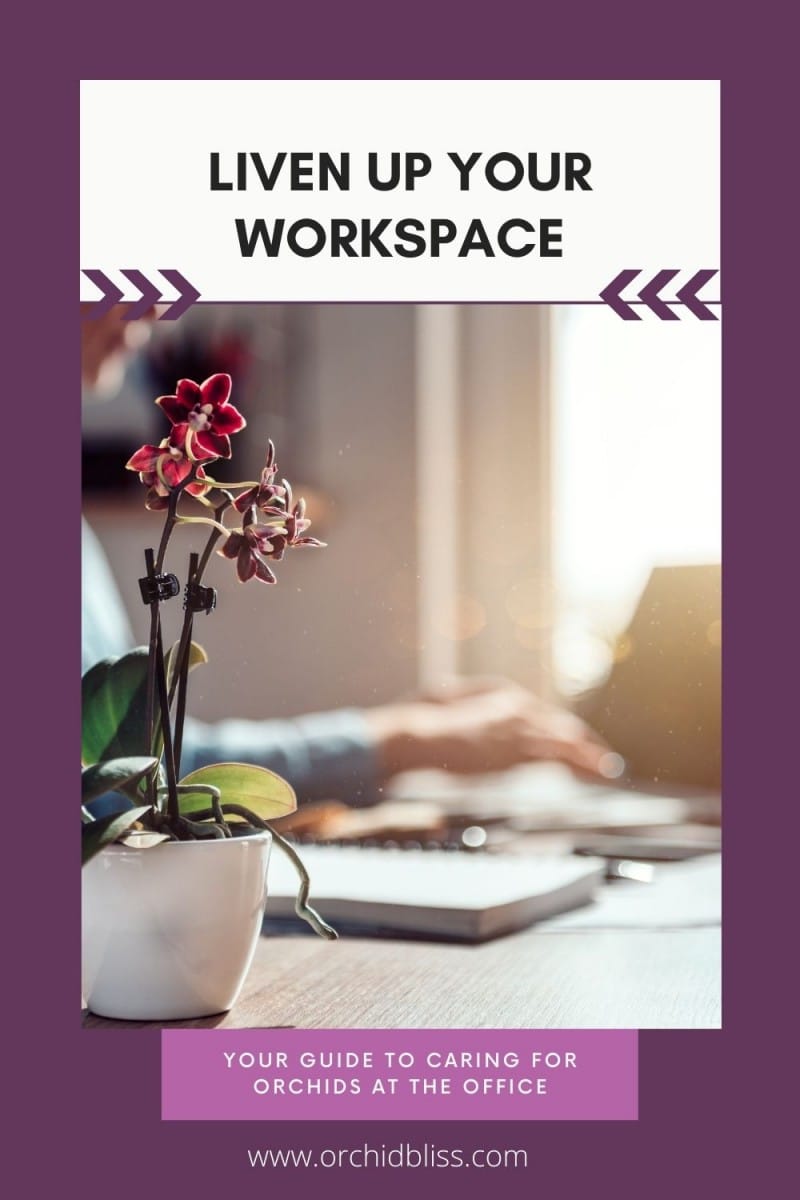
Give It the Light It Needs
Most orchids get ample indirect sunlight in their natural habitat. So, while you need to keep your room bright enough, you should keep your plant away from direct sunlight, especially at noon. Direct sunlight will burn the leaves and make the flowers droop.
Depending on your region’s sunlight intensity, you can place your plants on a south- or east-facing windowsill. West-facing windows are also suitable, but if the afternoon light is intense, you need to move the plant to protect it or cover the windows with a cloth.
But with some species, the flower spikes grow whichever direction the sun shines more brightly. If you constantly change the pot’s position, the spikes will grow unevenly. So, before buying the plant, make sure you have the right conditions light-wise.
Without enough light, you’ll get lush foliage growth but no blooms. So, if you see your office orchids don’t flower, the main culprit is most likely insufficient light.
To make sure the plant is getting adequate light, check the leaves. A happy, healthy orchid has bright green leaves. Lack of light manifests through dark green leaves and yellowish-green leaves with red hues signaling too much light.
Water the Plant Properly
When it comes to watering, orchids are sensitive and a bit picky. Their watering needs depend on various factors, including species, the pot’s material, the mixing pot, temperature, humidity, and light. For example, porous pots retain less moisture than non-porous ones.
Plus, some orchids are drought-resistant, while others are more sensitive. For instance, cattleyas, dendrobiums, and oncidiums are more drought-tolerant and need watering once a week. On the other hand, paphiopedilums, Miltonia, and Phragmipedium are less resistant to drought and need watering every 4 or 5 days.
No matter what the plant’s water requirements are, make sure to use room-temperature water. You’ll damage the plant’s cells if you use water more than 10° F (-12° C) below or above room temperature.
To be on the safe side, make sure the plant is almost dry when you decide to water it.
When you’re in the office, you might want to care for your beautiful companion by giving it some water. But you might end up killing it if you’re too kind to it. Feel the potting medium using your fingertips to make sure it’s almost dry and needs watering.
Make sure the pot is adequately drained and check to see if water runs through the holes. While you water the plants, be careful, so the crown doesn’t get wet, and if it does, dry it out using a piece of cloth. If the crown remains wet, it might cause crown rot, a deadly condition that kills your orchid.
Instead of pouring water from the top, immerse the whole pot in a container full of water. The water should cover the pot up to 0.5″ from the rim. Wait for 15 minutes until the roots absorb the water.
Watering the plant in the morning will increase the chance of excess water evaporation during the day. This way, the plant won’t remain wet overnight, reducing the likelihood of fungal infections, especially in humid regions.
Improper watering is often the cause of a droopy, unhealthy orchid. Click here to grab your cheat sheet to learn how to grow healthier orchids. It will be super helpful.
Provide Enough Humidity
Since most orchid species hail from tropical areas, they need high degrees of humidity. Their desired humidity range is 50 to 70 percent, which you can easily provide by using a humidifier.
Some species also need misting once or twice a week. Make sure to do it early in the morning when you arrive at the office to avoid water accumulation on the leaves and the crown.
You could also increase humidity by filling a dish or tray with pebbles and water and placing the pot in it. Ensure the pot doesn’t touch water by putting it right on top of the gravel.
However, since too much humidity can lead to rot, you should take lighting and temperature into account when you want to increase humidity. For example, suppose the temperatures drop at night. In that case, high humidity conditions can lead to condensation and create a wet film over the plant. So, induce humidity if your plant needs it.
Follow Its Temperature Requirements
The best temperature range for orchids is 50-85° F (10-29.5° C). Lower or higher temperatures may not kill the plant, but they’ll hinder its growth.
Ensure your office temperature is within the right range, especially when the air conditioning or heating is working. Plus, keep your plant away from direct air from these systems. Constant exposure to air can dry out their leaves and roots.
It’s also vital to maintain the right temperature during the night when you’re not at the office. Be sure to keep the nighttime temperature above 60° F (15.5° C). If you can’t control the temperature in your office, keeping an orchid may not be the best thing for you.
If you keep your orchids on windowsills, monitor temperature changes more carefully. Temperature fluctuations can prove deadly to the young buds, causing them to fall off without getting a chance to bloom.
Encourage New Growth
In case you see the flowers have dried out completely, help the plant develop new growth by cutting out the stem entirely. This way, instead of focusing its energy on the dead parts, the plant will be focused on growing new stems. You’ll see new flowers within a year.
If the spike has a mixture of spent and alive blooms, cut the stem below the last dead flower and above the first node that comes after it. You’ll encourage the plant to produce more flowers, and the stem will produce new flowers within 2 to 3 months.
Don’t Starve Your Plants
Orchids need food to thrive and bloom even though they can absorb nutrients from their surroundings.
Different species might have different fertilizer needs, especially during their growth and dormancy periods. But as a general rule of thumb, orchids need fertilizers every two weeks in spring and summer, when they’re in the full growth phase. When they’re resting during fall and winter, fertilizing them once a month will do. However, some experts recommend not providing any fertilizer during this period.
Fertilize or a half-strength 30-10-10 fertilizer during the growing months. But near the blooming season, lower the dose to a balanced combination like a half-strength 20-20-20.
Suppose you’re busy in your office and tend to forget your plant’s feeding needs. In that case, you could follow the “weakly, weekly” plan—the approach that experienced orchid enthusiasts follow.
However, don’t go overboard in feeding your orchids. Overfeeding can seriously damage your plants, eventually killing them. Even if they don’t die, they may stop flowering and grow lots of weak foliage that can’t mature. Plus, too much fertilization can burn and kill the roots.
If you’re sure whether you’ve overfed your plants, flush them with water so that the excess fertilizer runs out of the pot. In severe cases, it’s better to re-pot the plant.
Create Optimal Air Circulation
Air circulation is a friend to all orchids. After all, they’re used to the refreshing breezes of the tropics, drying their roots, leaves, and flowers and boosting their health.
Air circulation can cool down your plant, especially during the mid-day heat in the summer. Plus, it provides a uniform temperature distribution by preventing hot and cold air pockets in single spots. That’s especially important if you have a small office with only a few employees.
Air movement can prevent fungi and bacterial growth by drying the plants after you’ve watered them.
Overcrowding the area around the orchids can hamper air movement. So, resist the temptation to cover your windowsill with orchids. With orchids, less is more.
If your office air is stagnant, you could place an oscillating fan to help move the air. But remember not to put the fan directly in front of the orchids as it might dry out the leaves.
Watch Out for Pests or Diseases
While orchids are generally pest-resistant, it’s not uncommon to find the following pests:
- Scale forms on the underside of the orchid’s leaf. So, check the leaves every once in a while, and if you detect scales, rub them off, breaking their hard shells.
- Thrips are tiny common plant pests that look like gnats and reside on flowers or leaves. You could use neem oil to remove them.
- Aphids are sap-sucking creatures that create sticky droplets on orchids. You could spray cold water or use neem oil to get rid of them.
- Spider mites manifest as tiny webbings or specks on the leaves. You could wash them off using soap and water and then spray insecticidal soap on them.
- Mealybugs appear like a white cotton-like mass on petals, especially the top right one and the column. You can use a mix of treatments such as soap, isopropyl alcohol, or neem oil. If the infection is severe, Orthene can be useful.
And here are some possible diseases among orchids, although they’re scarce:
- Crown rot: It’s the result of overwatering or water accumulation in the crown (the central growing point). It makes the crown turn black and doesn’t have a treatment.
- Root rot: When the roots stay wet for a long time, they get mushy and dark, which is a sign of root rot. You could cut off the rotten roots and provide good air circulation. But if the problem has spread to all parts of the roots, with no green areas left, the plant is unsalvageable.
- Leaf spot: Fungal or bacterial infections create spots on leaves or blooms. The only solution is to cut off the infected leaves. But be careful not to touch the healthy leaves with the tool you used to cut the dead ones, or you’ll end up infecting them.
Other problems may not be so obvious or have serious underlying causes. Sometimes distress manifests in the form of yellowing or wrinkled leaves and delayed flowering. These are signs of distress caused by unfavorable conditions.
To find the exact cause, you should relocate the orchid and tweak the care routines. When the orchid finds its perfect spot, it will grow new roots, leaves, and spikes, finally rewarding its careful owner with flowers. To learn more about how to prevent, identify and treat orchid pests and diseases, click here.
Re-pot if Necessary
Orchids tend to outgrow their pots every two or three years. You’ll see the roots grow out of the pot. However, you may want to change the potting material sooner since it tends to decay. Follow the instructions above to provide your orchid with a bigger space.
Why Should You Keep Orchids in the Office?
Orchids are lavish flowers that greatly enhance your office’s aesthetic features, making them a pleasing addition to your space. But they’re more than aesthetically pleasing plants and can have many benefits.
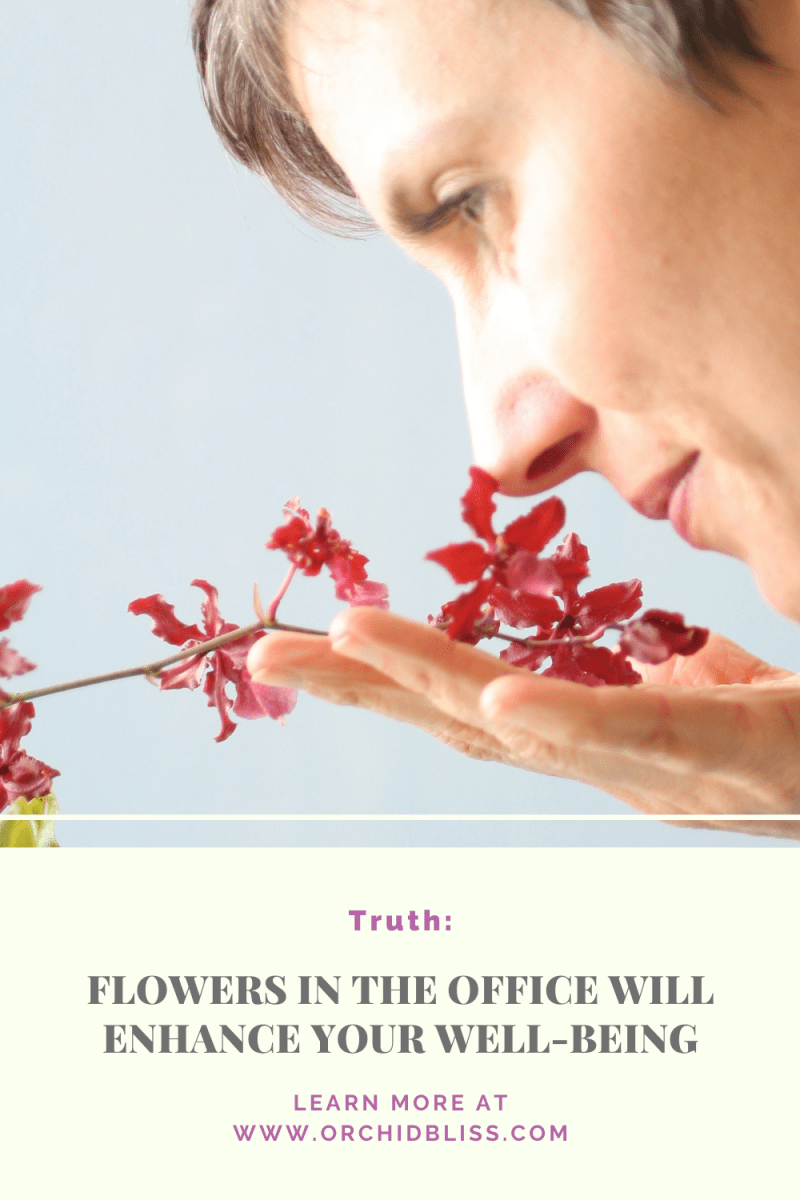
Here are the reasons you should keep orchids in your office:
They Are Mood Enhancers
While some people are frequently in elevated moods, others have difficulty feeling alive and motivated in their offices. Employees who have flowers in their offices can experience a rapid boost of energy in the morning. Plus, flowers can transfer happy feelings to others. So, you can rely on orchids as caffeine-free pick-me-up elements in your office.
Different colors in orchids bring out various aspects of your personality and affect your moods. For example, pink and yellow can help you feel more energetic, while white can enhance the feeling of cleanliness.
They Improve Air Quality
Air pollution in urban areas can easily penetrate indoor spaces. Plus, co-workers who are ill can transfer their germs to others. That’s why a natural air filter can be a valuable means of improving air quality.
Also, the space inside an office tends to be stuffier than other outside places since the air doesn’t circulate well. Plants, in general, can absorb volatile organic compounds and produce oxygen.
Conclusion
Who doesn’t want to have the show-stopping fragrant orchids in their offices? They can improve your mood, creativity, and performance by adding to your office’s beauty and air quality.
However, you need to make sure you know what orchids are suitable for your office and what they need. Consider their light, water, temperature, and humidity requirements before choosing the plant.
Avoid overfeeding, overwatering, too much direct sunlight, and too hot or too cold temperatures. When you keep them happy and healthy, they’ll reward you by producing vibrant flowers.


